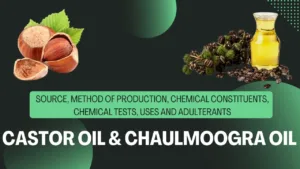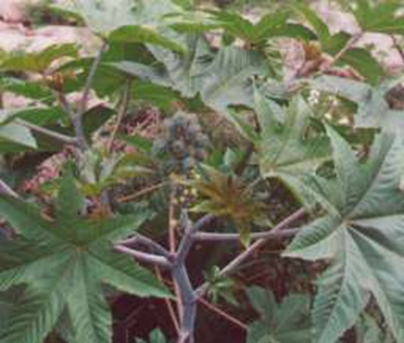Castor oil & Chaulmoogra oil
Source, method of production, chemical constituents, chemical tests, uses and adulterants

Contents
• Source, method of production, chemical constituents, chemical tests, uses and adulterants of Castor oil & Chaulmoogra oil
Objectives
At the end of this lecture, student will be able to
Discuss the source, method of production, chemical constituents, chemical tests, uses and adulterants of
• Castor oil
• Chaulmoogra oil
Castor Oil
Castor oil, derived from the seeds of the Ricinus communis plant, is a versatile vegetable oil known for its wide-ranging applications. The oil is obtained through a process of cold-pressing the seeds, which helps preserve their valuable nutrients and compounds.
Synonym
• Oleum ricini
Castor Oil Biological Source
• Fixed oil obtained by cold expression of the seeds of Ricinus communis
Family
• Euphorbiaceae
Geographical source of Castor Oil:
• Native to India
• Brazil, China, the former Soviet Union
• Seeds – sorted according to size, cracked
• Kernels – fed into the oil press, at ordinary temperature to a pressure of 1 to 2 tonnes per square inch
• Oil is filtered, steamed at 800C to 100oC – to remove RICIN and LIPASE
• Oil is filtered – Cold drawn medicinal oil – acidity 1
• Still cake contains 20% of oil
• Heated by steam to about 40-80oC and are pressed – Second quality oil
• Still contains 8-10% of oil – extracted by benzene or carbon di sulphide
• Cold drawn oil – bleached, deacidified, washed with hot water before steaming to remove mucilaginous matter
• Treated with activated or animal charcoal to remove impurities
Description of Castor Oil
• Pale yellow or almost colourless liquid
• Slight and characteristic odour
• First bland, later acrid and usually nauseating
• Viscous and transparent liquid
• Soluble in alcohol, miscible in chloroform, solvent ether, glacial acetic acid and petroleum ether
Chemical constituents of Castor Oil
• Ricinoleic acid, isoricinoleic, linoleic, stearic and isostearic acids
• Purgative action – free ricinoleic acid and its stereoisomer – hydrolysis in the duodenum
• Viscosity – due to ricinoleic acid
• Vitamin F – hair growth
Chemical test of Castor Oil
• With equal volume of dehydrated alcohol the solution remains clear. On cooling at 0oC and on storage for 3 hours, the liquid remains clear
• With half of its volume of petroleum ether – clear solution
• With twice its volume – turbid and partially soluble
Castor Oil Uses
• Cathartic
• Lubricating agent
• Turkish red oil, paints, varnish, enamel, grease, polishes etc
• Atropine and cocaine for ophthalmic purpose – suspended in castor oil
• Emollient for cosmetics, hair fixers, plasticiser
• Hydrogenated and dehydrogenated castor oil – industrial purpose
Allied drugs of Castor Oil
Croton seeds:
• Croton tiglium (Euphorbiaceae) – 50% of fixed oil, resin and crotin
Physic nuts or purging nuts:
• Jatropha curcas (Euphorbiaceae)- 40% of fixed oil, curcin
Abrus seeds:
• Abrus precatorius (Leguminosae) – glycoprotein, abrin
Chaulmoogra oil
Chaulmoogra oil is extracted from the seeds of the Hydnocarpus wightiana tree, primarily found in parts of Asia. With a long history of use in traditional medicine, this oil has gained attention for its potential therapeutic properties.

Synonym
• Gynocardia oil, Hydnocarpus oil
Chaulmoogra oil Biological Source
• Fixed oil obtained by cold expression from the ripe seeds of Taraktogenous kurzii (Bixaceae), Hydnocarpus heterophylla, H. anthelmintica, and other species of Hydnocarpus (Flacourtiaceae)
Method of preparation of Chaulmoogra oil
• Seeds – 40-45% of fixed oil
• Cleaned, washed and dried
• Testa is cracked and removed
• Kernel – paste, kept in jute bags
• Piled up and the oil is expressed by hydraulic press
Description of Chaulmoogra oil
• Yellow to brownish yellow colour
• Characteristic odour, Acrid taste
• Slightly soluble in alcohol, soluble in chloroform, ether, benzene and CS2
Standards
• SG: 0.935-0.960
• AV: not more than 10
• SV: 195-213
• IV: 93-104
• Specific rotation: not less than +48 and not more than +60
• Unsaturated fatty acids of chaulmoogric acid and hydnocarpic acid
• Glycerides of palmitic acid
Uses of Chaulmoogra oil
• Strong antibacterial activity against Mycobacterium leprae and M. tuberculae
• Treatment of leprosy and tuberculosis
• Treatment of psoriasis and rheumatism
Substituents
• H. wightiana, H.alpine
Summary
• Castor oil is the fixed oil from Ricinus communis by cold expression method
• Impurities like ricin and lipase should be removed
• It contains ricinoleic acid which has cathartic action
• Hydnocarpus oil is also called as gynocardia oil and chaulmoogra oil
• It contains chaulmoogric acid and hydnocarpic acid
• Hydnocarpus oil used against Mycobacterium leprae and Mycobacterium tuberculae
FAQs
- Are castor oil and chaulmoogra oil safe for all skin types? Castor oil is generally safe for most skin types, but a patch test is recommended. Chaulmoogra oil should be used under professional guidance, especially for sensitive skin.
- Can castor oil be ingested for its health benefits? While castor oil has been used for its laxative effects, ingesting it in large amounts can lead to adverse effects. It’s best to consult a healthcare professional.
- Is chaulmoogra oil still used to treat leprosy? While chaulmoogra oil was historically used in leprosy treatment, modern medicine has other effective treatments. It may still be used in traditional practices.
- How can I identify if my castor oil is pure? Perform the Salkowski test by mixing castor oil with sulfuric acid. A reddish-brown ring indicates the presence of castor oil.
- Where can I access high-quality castor oil and chaulmoogra oil? Access authentic oils from reputable suppliers.
Also, Visit: Pharmacognosy Notes for Pharma students

